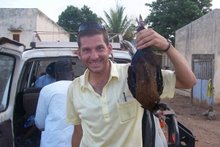
It has been raining constantly for the last three weeks. Beside the fact that nothing dries do to the moist air, the strong rains have been flooding the low areas in Nicaragua and really hurting the bean harvest-to the point that if the rain keeps up for two more weeks, there will be no beans left for the farmers to harvest and could cause a major food shortage in the coming year.
On a brighter note, I have only four more weeks left of training and I actually start my volunteering experience in my own site. This past week I stayed with another volunteer in their site. We built a biogas digester and improved cooking stove. Real quick-a biogas digester is basically a tank in the ground that you add cow manure into daily. The manure degrades and turns into methane gas which can be used as a clean odorless gas for cooking. The excess manure turns into fertilizer for your garden. The only costs for this project include the initial capital for the tank(about $150)-everything else is free as long as you or a neighbor have at least two cattle. We were able to talk with the people in the village and learn what they were interested changing and potentially adding to their village. Then just yesterday, I visited a very active community who are involved with smart and sustainable ag. business products. Within the village they have big fruit tree producer. He uses all sorts of neat technologies to water and fertilizer his crops. Then his neighbor uses worms to make fertilizer which the tree farmer uses for his fields. The community also has a cooperative started to utilize a truck to transport their products to market in a bigger city.
One of the goals of the Peace Corps is to live like the people of Nicaragua, which includes receiving the same amount of income. I am finally understanding how far $1 will really go. My friend and I refuse to take the bus into town for only 6 Cordobas, we walk the 15 or so blocks one way. The exchange rate is $1 = 20Cordobas, so 6 Cordobas is about $0.12, but adds up to $0.50 in two trips! I have to quit calculating what the cost is in US dollars, because everything here is really cheap for American standards-even when ice cream costs $0.10 for the flavor of the week!
Another great opportunity I was able to be apart of was actually making my coffee-from start to finish. My family has a coffee plant in our yard which they use for coffee, but since coffee harvesting season isn’t till November, they bough some coffee in a neighboring district where the harvest is going on now. I put the coffee beans in a big pot on the hot wood fire to toast to perfection. I have to constantly stir the beans to give an even toast to every single bean. To check the desired toasting level, I just had to smell the beans as it was on the fire. I decided to go for a medium to medium-dark roast (plus or minus a whole range as I really had no clue what it was supposed to be like) which took close to 40 mins on the fire. After toasting the beans, I had to grind the bea
 ns in a Mollena. This is a hand crank device which they use for just about all types of food-including corn and even chicken. I set the grind to be fairly fine so when they brew the coffee, the grounds sink to the bottom of the pot and I don’t have to choke them down. They don’t use filters, just a dash of cold water on top of the grinds to help them sink to the bottom of the pot (kinda like cowboy coffee when your are camping!) After a solid hour of grinding, I had close to a 2 - ½ gallon bucket full of grounds. Sounds like a lot, but this will probably only last my family a month. It is very common for Nicaraguan’s to drink a lot of coffee throughout the day. We always have at least one cup for breakfast. A half pot of coffee is kept on the hot coals just in case they have a visitor and need to share a cup. They then drink a cup for lunch. And finally after a good hard days work, they will enjoy a cup for dinner. After all the work that I now know goes into one cup of coffee-the coffee tastes all the better!!
ns in a Mollena. This is a hand crank device which they use for just about all types of food-including corn and even chicken. I set the grind to be fairly fine so when they brew the coffee, the grounds sink to the bottom of the pot and I don’t have to choke them down. They don’t use filters, just a dash of cold water on top of the grinds to help them sink to the bottom of the pot (kinda like cowboy coffee when your are camping!) After a solid hour of grinding, I had close to a 2 - ½ gallon bucket full of grounds. Sounds like a lot, but this will probably only last my family a month. It is very common for Nicaraguan’s to drink a lot of coffee throughout the day. We always have at least one cup for breakfast. A half pot of coffee is kept on the hot coals just in case they have a visitor and need to share a cup. They then drink a cup for lunch. And finally after a good hard days work, they will enjoy a cup for dinner. After all the work that I now know goes into one cup of coffee-the coffee tastes all the better!!I wish all of you the best-and hope you enjoy that cup of coffee!!
~Wes~
